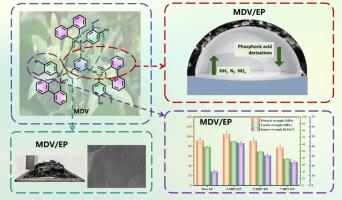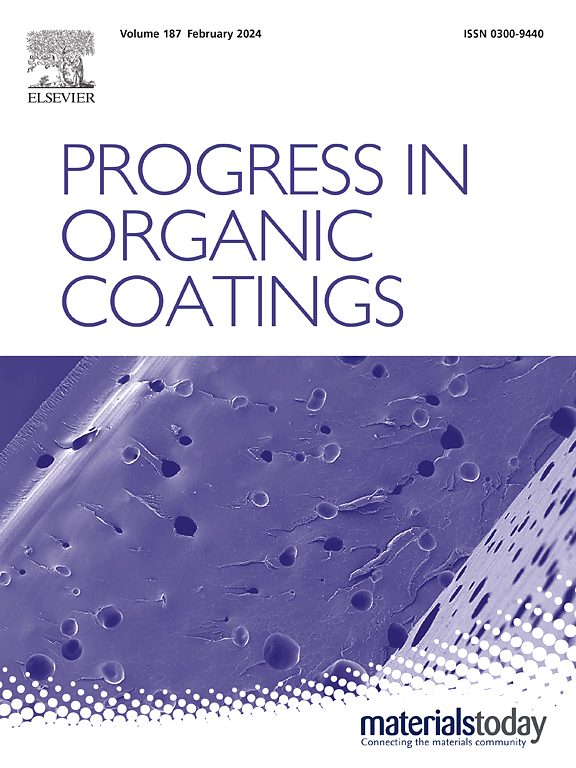Melamine-based biomass-containing P/N synergistic flame retardants confer superb flame retardancy and toughness to epoxy resins
IF 7.3
2区 材料科学
Q1 CHEMISTRY, APPLIED
引用次数: 0
Abstract
Epoxy resin (EPs) coatings for aircraft need to have good flame retardant properties and toughness. On the other hand, to meet the needs of sustainable development, EPs also have high environmental friendliness and low cost requirements. In light of this, a one-pot approach was used to create a bio-based phosphorus‑nitrogen synergistic flame retardant (MDV) employing DOPO, vanillin, and MA as raw materials. The results showed that MDV can give EP superb flame retardancy and toughness. With the addition of 3 wt% MDV, the tensile and flexural strengths of EP composites increased by 13.6 % and 14.5 %, respectively, and the impact strength increased from 13.9 KJ/m2 to 43.1 KJ/m2. The excellent toughness enhancement comes from the fact that the structure of MDV itself can preferentially consume and dissipate energy when counteracting external impacts. In addition, MDV/EP also has excellent flame retardant properties, showing good self-extinguishing capability off fire in tests. Compared with pure EP, the total heat release (THR) and peak heat release rate (PHRR) of 7-MDV/EP composites were reduced by 45.3 % and 64.5 %, respectively. Mechanistic analyzes showed that the segregation of the condensed phase and the gas-phase flame-retardant effect both originated from the P/N synergistic effect, which was the source of the excellent flame-retardant effect of MDV/EP.

基于三聚氰胺的含生物质 P/N 协同阻燃剂赋予环氧树脂极佳的阻燃性和韧性
飞机用环氧树脂(EPs)涂料需要具有良好的阻燃性能和韧性。另一方面,为了满足可持续发展的需要,环氧树脂还具有高环保性和低成本的要求。有鉴于此,研究人员以 DOPO、香兰素和 MA 为原料,采用一锅法制备了生物基磷氮协同阻燃剂(MDV)。结果表明,MDV 能赋予 EP 极好的阻燃性和韧性。添加 3 wt% 的 MDV 后,EP 复合材料的拉伸强度和弯曲强度分别提高了 13.6% 和 14.5%,冲击强度从 13.9 KJ/m2 提高到 43.1 KJ/m2。出色的韧性增强源于 MDV 本身的结构在抵消外部冲击时可以优先消耗和消散能量。此外,MDV/EP 还具有优异的阻燃性能,在测试中显示出良好的离火自熄能力。与纯 EP 相比,7-MDV/EP 复合材料的总放热量(THR)和峰值放热率(PHRR)分别降低了 45.3% 和 64.5%。机理分析表明,凝结相的离析和气相阻燃效应都源于 P/N 协同效应,这是 MDV/EP 优异阻燃效果的来源。
本文章由计算机程序翻译,如有差异,请以英文原文为准。
求助全文
约1分钟内获得全文
求助全文
来源期刊

Progress in Organic Coatings
工程技术-材料科学:膜
CiteScore
11.40
自引率
15.20%
发文量
577
审稿时长
48 days
期刊介绍:
The aim of this international journal is to analyse and publicise the progress and current state of knowledge in the field of organic coatings and related materials. The Editors and the Editorial Board members will solicit both review and research papers from academic and industrial scientists who are actively engaged in research and development or, in the case of review papers, have extensive experience in the subject to be reviewed. Unsolicited manuscripts will be accepted if they meet the journal''s requirements. The journal publishes papers dealing with such subjects as:
• Chemical, physical and technological properties of organic coatings and related materials
• Problems and methods of preparation, manufacture and application of these materials
• Performance, testing and analysis.
 求助内容:
求助内容: 应助结果提醒方式:
应助结果提醒方式:


